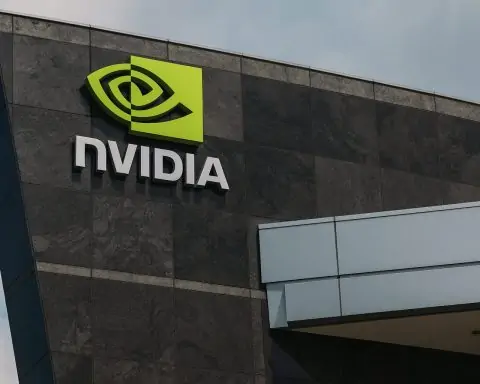SanDisk is closing out the week with a potent mix of tiny hardware and big numbers. A new “plug‑and‑stay” 1TB USB‑C flash drive is hitting headlines today, while the company’s surging earnings, aggressive NAND price hikes, and fresh analyst upgrades keep SNDK front and center for investors.
Below is a full rundown of what’s happening with SanDisk today, how it fits into the broader memory‑chip crunch, and what it means for SNDK shareholders.
SanDisk’s new 1TB Extreme Fit drive goes viral today
Photography and camera-gear site SonyAlphaRumors today highlighted SanDisk’s minuscule 1TB Extreme Fit USB‑C flash drive, calling out how the 1TB version weighs just 3 grams and measures about 18.5 × 13.7 × 16 mm—barely larger than its USB‑C connector itself. [1]
The Extreme Fit has actually been rolling out across tech and deal sites over the past two weeks:
- 9to5Toys describes it as the “world’s smallest 1TB USB‑C flash drive,” with capacities from 64GB to 1TB and street prices starting around $15.99. [2]
- PetaPixel notes that SanDisk markets it as a “plug and stay” drive: it’s small enough to leave semi‑permanently plugged into a laptop, tablet, or other USB‑C device. The drive uses USB 3.2 Gen 1 with speeds up to 400 MB/s, enough for photo and video transfer but not intended as a high‑end editing drive. [3]
Today’s fresh wave of coverage, especially in photography circles, is keeping the product in the spotlight just as holiday shopping and Black Friday deals ramp up. For SanDisk, the Extreme Fit checks a few strategic boxes:
- High‑margin, premium SKU: Ultra‑compact 1TB flash drives typically command higher prices per gigabyte than commodity SSDs.
- Perfect fit for laptops & creators: The drive’s near‑flush profile appeals to creators, travelers and students who want “invisible” extra storage. [4]
- Cross‑selling moment: It gives SanDisk a hero consumer product to promote precisely when memory prices—and investor attention—are spiking.
AI boom triggers NAND shortage and steep price hikes
SanDisk’s shiny new flash drive arrives in the middle of a severe global memory crunch that is reshaping the entire storage market.
Up to 50% price jumps in November
According to reporting summarized by Tom’s Hardware and storage vendor OSCOO, SanDisk has increased NAND flash contract prices by as much as 50% for November 2025, after earlier hikes of around 10% in April and September. [5]
Key points from those reports:
- This is at least the third price increase SanDisk has implemented this year. [6]
- Some downstream manufacturers—including industrial SSD and module suppliers—have reportedly halted shipments while they renegotiate pricing or wait for clarity. [7]
- Wafer fabs are prioritizing high‑margin DRAM (notably DDR5 and HBM for AI accelerators), leaving less capacity for lower‑margin NAND and DDR4. [8]
Today, Tom’s Hardware adds another layer: major PC brands like Asus and MSI are described as panic-buying RAM and other memory components on the spot market, as AI data centers soak up supply and push up prices for both DRAM and NAND. [9]
The result: a “pricing apocalypse” for memory that could last years if demand stays elevated and capacity additions remain slow.
Undersupply projected beyond 2026
A recent TrendForce analysis centered on SanDisk’s commentary suggests the NAND market will remain undersupplied through at least the end of 2026, with customers already trying to secure volumes into 2027. [10]
TrendForce ties this to:
- A shift from AI training to more widespread inference workloads in the cloud.
- Surging demand for high‑capacity SSDs and flash‑dense storage systems.
- Cautious capex from memory makers who fear over‑building if the AI boom cools. [11]
For SanDisk, this environment is a double-edged sword: it supports higher selling prices and better utilization, but also heightens political and customer scrutiny around price spikes.
Spin‑off complete: SanDisk stands alone again
This year also marks SanDisk’s full return as an independent flash specialist. Western Digital completed the separation of its flash business in February 2025, leaving HDDs with Western Digital and spinning out SSD/flash operations under the SanDisk banner. [12]
Analysts like GuruFocus now describe SanDisk as one of the five largest NAND suppliers globally, vertically integrated via joint ventures with Kioxia in Japan and repackaging most of its output into consumer, enterprise and cloud SSD products. [13]
This clean structure makes SNDK a pure play on flash memory and SSD demand—including all the upside (and risk) of the current AI‑driven boom.
Blowout Q1 FY2026 results fuel the rally
SanDisk’s latest earnings report, covering fiscal Q1 2026 (quarter ended October 3, 2025), was the spark that really lit up the stock this month.
According to MarketBeat’s recap of the release:
- Revenue: about $2.31 billion, beating consensus estimates near $2.12 billion and up roughly 22.6% year‑on‑year. [14]
- Earnings per share (EPS):$1.22, more than double the Street’s ~$0.58 expectation. [15]
- Guidance: management set Q2 FY2026 EPS guidance in the range of $3.00 to $3.40, a very aggressive outlook that assumes continued strength in AI‑driven storage demand. [16]
A separate breakdown from GuruFocus and StocksToTrade adds more color:
- Trailing revenue is around $7.4 billion, with a 3‑year CAGR near 25%. [17]
- Net income for the recent period is about $112 million; operating cash flow roughly $488 million, and free cash flow about $438 million, reflecting strong cash generation even as margins are still rebuilding from the down‑cycle. [18]
- The balance sheet shows low leverage (debt‑to‑equity around 0.2) and solid liquidity ratios, including a current ratio above 3x. [19]
Put simply: SanDisk is emerging from the memory downturn with rapid growth, improving profitability, and a much healthier balance sheet than many would have expected a year ago.
SNDK stock today: monster run, extreme volatility
All of this has translated into a wild ride for shareholders.
As of the latest available close (Friday, 14 November 2025), SanDisk Corporation (NASDAQ: SNDK):
- Closed at $254.16, up 4.35% on the day, with after‑hours trading nudging it above $258. [20]
- Trades between $28.27 and $284.76 over the past 52 weeks—meaning the stock is up more than 800% from its lows and still about 10% below its peak. [21]
- Shows a one‑month performance of roughly +85%, reflecting just how quickly sentiment has flipped. [22]
Technical and valuation metrics are equally dramatic:
- MarketBeat pegs SanDisk’s P/E ratio near 794x, driven by still‑depressed trailing earnings versus an explosive share price. [23]
- GuruFocus lists a price‑to‑sales ratio around 5.5 and price‑to‑book above 3x, levels that assume sustained high growth and margins. [24]
- TradingView and other sources show volatility above 15% and a beta well over 2, underscoring just how quickly SNDK can move. [25]
On Friday, StocksToTrade flagged SNDK as up 7.06% intraday, with an intraday range from about $235 to $270 and commentary emphasizing both the opportunity and the risk for active traders. [26]
Wall Street sentiment: upgrades, but caution on valuation
Today’s big Street‑level headline comes from MarketBeat, which reports that Wall Street Zen has upgraded SanDisk from “Hold” to “Strong Buy” following its Q1 earnings beat and aggressive outlook. [27]
Highlights from the same piece:
- SanDisk’s recent quarter beat expectations on both revenue and EPS, and guidance implies much higher profitability next quarter. [28]
- The broader analyst set now includes 2 Strong Buy, 11 Buy, 7 Hold and 1 Sell ratings, with an overall consensus of “Moderate Buy.” [29]
- Interestingly, the average price target is still around $183, far below the current ~$250+ share price—suggesting either targets will be revised upward, or analysts think the stock has run ahead of fundamentals. [30]
Other coverage, such as MarketBeat’s “Is SanDisk Still a Buy After 118% AI‑Fueled Surge?” and various tech‑sector roundups, position SNDK as one of 2025’s breakout AI‑adjacent hardware plays, but consistently stress the cyclical and capital‑intensive nature of memory manufacturing. [31]
How today’s news fits together
Putting it all in one picture:
- Consumer spotlight:
- Today’s chatter around the Extreme Fit 1TB USB‑C drive gives SanDisk a consumer‑friendly, highly visible product just as holiday shoppers start thinking about storage upgrades. [32]
- Supply‑demand squeeze:
- SanDisk’s 50% NAND price hikes in November and commentary about undersupply into 2027 show that the Extreme Fit isn’t just a gadget story; it’s a symptom of a much larger AI‑driven memory crunch. [33]
- Financial momentum:
- Q1 FY2026 earnings and Q2 guidance point to rapid revenue growth and improving profitability, especially in data‑center and enterprise SSD lines that benefit most from higher NAND prices. [34]
- Stock market reaction:
- SNDK has transformed from distressed memory name to hyper‑growth AI infrastructure play in less than a year, with the share price multiplying several‑fold and volatility soaring. [35]
- Analyst stance:
- The upgrade to Strong Buy and accumulation by institutional investors show broad recognition of SanDisk’s turnaround—but average targets lag the current price, underlining worries that the stock may already be pricing in a lot of good news. [36]
What to watch next for SanDisk and SNDK
For readers following SanDisk closely—whether as customers, partners, or investors—today’s developments sharpen a few key questions:
- Can SanDisk sustain these margins?
Elevated NAND prices are great for profits now, but history shows memory cycles can reverse sharply if supply catches up or AI demand normalizes. [37] - Will regulators or customers push back on price hikes?
A 50% jump in contract pricing, on top of earlier increases, will not go unnoticed by large OEMs and data‑center buyers, especially if shortages are prolonged. [38] - Can product quality perceptions keep up?
PetaPixel points out that SanDisk is still contending with reputational damage from past portable SSD failures, even as it rolls out new branding and flagship products like Extreme Fit. [39] - Is SNDK priced for perfection?
With valuation multiples stretched, any disappointment—whether in guidance, pricing power, or AI spending trends—could trigger sharp downside moves, just as quickly as the stock rallied. [40]
As always, nothing here is individualized investment advice, but today’s mix of new hardware buzz, aggressive pricing, and strong earnings momentum makes SanDisk one of the most closely watched names in the semiconductor and storage universe right now.
References
1. www.sonyalpharumors.com, 2. 9to5toys.com, 3. petapixel.com, 4. petapixel.com, 5. www.tomshardware.com, 6. www.oscoo.com, 7. www.tomshardware.com, 8. www.tomshardware.com, 9. www.tomshardware.com, 10. www.trendforce.com, 11. www.trendforce.com, 12. www.trendforce.com, 13. www.gurufocus.com, 14. www.marketbeat.com, 15. www.marketbeat.com, 16. www.marketbeat.com, 17. www.gurufocus.com, 18. stockstotrade.com, 19. www.gurufocus.com, 20. www.investing.com, 21. www.investing.com, 22. www.stockstelegraph.com, 23. www.marketbeat.com, 24. www.gurufocus.com, 25. www.tradingview.com, 26. stockstotrade.com, 27. www.marketbeat.com, 28. www.marketbeat.com, 29. www.marketbeat.com, 30. www.marketbeat.com, 31. www.marketbeat.com, 32. www.sonyalpharumors.com, 33. www.tomshardware.com, 34. www.marketbeat.com, 35. www.investing.com, 36. www.marketbeat.com, 37. www.trendforce.com, 38. www.tomshardware.com, 39. petapixel.com, 40. www.investing.com










